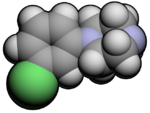Meta-hlorofenilpiperazin
meta-Hlorofenilpiperazin (mCPP) je psihoaktivni lek iz fenilpiperazinske klase. On je razvijen krajem 1970-tih godina i korišten je u naučnim istraživanjima, pre nego što je postao dezijnirana droga sredinom 2000-tih.[1][2] mCPP je detektovan u pilulama koje su reklamirane kao legalne alternative za nedopuštne stimulanse u Novom Zelandu i u pilulama koje su prodavane kao "ekstazi" u Evropi i Sjedinjenim Državama.[3][4]
 | |
 | |
| IUPAC ime | |
|---|---|
1-(3-hlorofenil)piperazin | |
| Klinički podaci | |
| Način primene | Oralno, nazalno, rektalno |
| Farmakokinetički podaci | |
| Metabolizam | Hepatic |
| Poluvreme eliminacije | 2-6 sata |
| Izlučivanje | Renalno |
| Identifikatori | |
| CAS broj | 6640-24-0 |
| ATC kod | none |
| PubChem | CID 1355 |
| IUPHAR/BPS | 142 |
| ChemSpider | 1314 |
| ChEBI | CHEBI:10588 |
| ChEMBL | CHEMBL478 |
| Hemijski podaci | |
| Formula | C10H13ClN2 |
| Molarna masa | 196,676 g/mol |
| |
| |
Uprkos pokušaja da se uvede u upotrebu kao rekreaciona supstanca, mCPP se zapravo generalno smatra nepoželjnim jer proizvodi neprijatna iskustva.[3] Njemu nedostaju potkrepljujući efekti,[5] proizvodi depresivne i anksiogene efekte kod glodara i ljudi,[6][7] i može da indukuje panične napade kod osoba koje su im podložne.[8][9][10][11] On takođe pogoršava opsesivno-kompulzivne simptome kod ljudi sa tim poremećajem.[12][13][14]
Vidi još
уреди- 1-Benzilpiperazin (BZP)
- 1-Metil-4-benzilpiperazin (MBZP)
- 1,4-Dibenzilpiperazin (DBZP)
- 3-Trifluorometilfenilpiperazin (TFMPP)
- 3,4-Metilendioksi-1-benzilpiperazin (MDBZP)
- 4-Bromo-2,5-dimetoksi-1-benzilpiperazin (2C-B-BZP)
- 4-Fluorofenilpiperazin (pFPP)
- 4-Metoksifenilpiperazin (MeOPP)
- Etoperidon, Nefazodon, Trazodon - Metaboliziju se u mCPP.
- Hipazin - Srodni piperazinski serotoninski agonist.
- Org 12,962
References
уреди- ^ Bossong MG, Van Dijk JP, Niesink RJ (2005). „Methylone and mCPP, two new drugs of abuse?”. Addiction Biology. 10 (4): 321—3. PMID 16318952. doi:10.1080/13556210500350794. Архивирано из оригинала 05. 01. 2013. г. Приступљено 16. 11. 2012.
- ^ Lecompte Y, Evrard I, Arditti J (2006). „[Metachlorophenylpiperazine (mCPP): a new designer drug]”. Thérapie (на језику: French). 61 (6): 523—30. PMID 17348609.
- ^ а б Bossong, M.; T, Brunt; Van Dijk J; et al. (2009). „mCPP: an undesired addition to the ecstasy market”. Journal of Psychopharmacology (Oxford, England). 24 (9): 1395—401. PMID 19304863. doi:10.1177/0269881109102541.
- ^ Vogels N, Brunt TM, Rigter S, van Dijk P, Vervaeke H, Niesink RJ (2009). „Content of ecstasy in the Netherlands: 1993-2008”. Addiction (Abingdon, England). 104 (12): 2057—66. PMID 19804461. doi:10.1111/j.1360-0443.2009.02707.x. Архивирано из оригинала 05. 01. 2013. г. Приступљено 16. 11. 2012.
- ^ Tancer M, Johanson CE (2003). „Reinforcing, subjective, and physiological effects of MDMA in humans: a comparison with d-amphetamine and mCPP”. Drug and Alcohol Dependence. 72 (1): 33—44. PMID 14563541. doi:10.1016/S0376-8716(03)00172-8.
- ^ Rajkumar R, Pandey DK, Mahesh R, Radha R (2009). „1-(m-Chlorophenyl)piperazine induces depressogenic-like behaviour in rodents by stimulating the neuronal 5-HT(2A) receptors: proposal of a modified rodent antidepressant assay”. European Journal of Pharmacology. 608 (1-3): 32—41. PMID 19269287. doi:10.1016/j.ejphar.2009.02.041.
- ^ Kennett GA, Whitton P, Shah K, Curzon G (1989). „Anxiogenic-like effects of mCPP and TFMPP in animal models are opposed by 5-HT1C receptor antagonists”. European Journal of Pharmacology. 164 (3): 445—54. PMID 2767117. doi:10.1016/0014-2999(89)90252-5.
- ^ Klein E, Zohar J, Geraci MF, Murphy DL, Uhde TW (1991). „Anxiogenic effects of m-CPP in patients with panic disorder: comparison to caffeine's anxiogenic effects”. Biological Psychiatry. 30 (10): 973—84. PMID 1756202. doi:10.1016/0006-3223(91)90119-7.
- ^ Charney DS, Woods SW, Goodman WK, Heninger GR (1987). „Serotonin function in anxiety. II. Effects of the serotonin agonist MCPP in panic disorder patients and healthy subjects”. Psychopharmacology. 92 (1): 14—24. PMID 3110824.
- ^ Van Veen JF, Van der Wee NJ, Fiselier J, Van Vliet IM, Westenberg HG (2007). „Behavioural effects of rapid intravenous administration of meta-chlorophenylpiperazine (m-CPP) in patients with generalized social anxiety disorder, panic disorder and healthy controls”. European Neuropsychopharmacology : the Journal of the European College of Neuropsychopharmacology. 17 (10): 637—42. PMID 17481859. doi:10.1016/j.euroneuro.2007.03.005.
- ^ van der Wee NJ, Fiselier J, van Megen HJ, Westenberg HG (2004). „Behavioural effects of rapid intravenous administration of meta-chlorophenylpiperazine in patients with panic disorder and controls”. European Neuropsychopharmacology : the Journal of the European College of Neuropsychopharmacology. 14 (5): 413—7. PMID 15336303. doi:10.1016/j.euroneuro.2004.01.001.
- ^ Hollander, E.; DeCaria, C. M.; Nitescu, A.; et al. (1992). „Serotonergic function in obsessive-compulsive disorder. Behavioral and neuroendocrine responses to oral m-chlorophenylpiperazine and fenfluramine in patients and healthy volunteers”. Archives of General Psychiatry. 49 (1): 21—8. PMID 1728249.[мртва веза]
- ^ Broocks, A.; Pigott, T. A.; Hill, J. L.; et al. (1998). „Acute intravenous administration of ondansetron and m-CPP, alone and in combination, in patients with obsessive-compulsive disorder (OCD): behavioral and biological results”. Psychiatry Research. 79 (1): 11—20. PMID 9676822. doi:10.1016/S0165-1781(98)00029-8.
- ^ Pigott, T. A.; Zohar, J.; Hill, J. L.; et al. (1991). „Metergoline blocks the behavioral and neuroendocrine effects of orally administered m-chlorophenylpiperazine in patients with obsessive-compulsive disorder”. Biological Psychiatry. 29 (5): 418—26. PMID 2018816. doi:10.1016/0006-3223(91)90264-M.